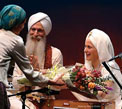
GuruGanesha Singh & Snatam Kaur
GuruGanesha Singh
is an icon of the yoga music genre. A musician deeply devoted to both his craft and the greater landscape of sacred sound, GuruGanesha’s contribution to World Sacred Music is manifold. His two solo releases of Sikh-inspired chant music enhanced by his virtuoso guitar work, Pure Ganesh and Grateful Ganesh, are beloved by his fans world-wide. Pure Ganesh put GuruGanesha Singh on the map as a solo musician, topping New Age charts in early 2007 and receiving high critical acclaim from magazine reviewers in both New Age and Yoga publications. Long before GuruGanesha Singh released his solo albums, he was the force behind many well known chant musicians, including Snatam Kaur, Thomas Barquee, and Mirabai and released several albums with other musicians including Game of Chants with Guru Singh and Grammy-Winning singer, Seal.
GuruGanesha Singh is also the original founder of the record label, Spirit Voyage Records, as well as the distribution company, Spirit Voyage Music. He founded both businesses with the intention of creating new avenues for spreading inspiring music to ever-widening audiences.
GuruGanesha performs over a hundred musical performances per year, from the Bahamas to Singapore on the Celebrate Peace World Tour with Snatam Kaur, in addition to teaching yoga classes and prosperity workshops, and recording new music. His unmitigated joy and virtuoso guitar work make him an instant favorite with the audiences around the world.
Snatam Kaur
was introduced to music and spiritual practice at an early age. Schooled in kirtan, meditation, and Gurmukhi, the Sanskrit-based language of Sikh scriptures from Northern India, the young Snatam Kaur began to develop the devotion and skills that have grown and blossomed into a compelling, profound talent.
Snatam Kaur's parents brought her up in the Sikh tradition as taught by Yogi Bhajan. From an early age, she practiced yoga and meditation daily and her mother taught her Gurmukhi. "My mother taught me the alphabet on my way to school every morning," recalls Snatam. Her Sikh community augmented these lessons with instruction in kirtan (devotional chanting). "Through these experiences, I learned the pronunciation," she says, "but also I learned the passion for what I was singing because these gatherings were so spiritual."
As a child, Snatam also had training in voice, violin, guitar, and percussion. She obtained a solid foundation in Western classical music while playing violin in an orchestra and giving solo performances. Her many opportunities to use and expand her musical talent in a spiritual setting emphasized for her the connection between her music and spirituality. "I learned about the importance of sound currents from Yogi Bhajan," she says, "but I also had the personal experience of how the energy of these sacred words can have a very real, positive effect."
Snatam further explored the power of sound in India. After high school, her love for the Indian musical tradition and for children took her to Miri Piri Academy, a boarding school for children in India. She spent time taking care of the young children, teaching physical education, and providing music for the children's morning and evening chanting. When she returned to the United States, she attended Mills College in Oakland, California, where she obtained a degree in biochemistry, taught yoga classes, and shared her chants with Western audiences. But India called her back. After touring and performing Kirtan in northern India, Snatam settled in Amritsar where she studied music with the accomplished ragi (Indian master of Sikh-style kirtan) Bhai Hari Singh. This was a great honor for her, and particularly meaningful because Singh was the same teacher who had taught her mother when she was just a little girl.
Snatam embraced everything that Singh taught her, from the technical aspects of the notes, to the ability to sing with presence and awareness. The lessons took place in Singh's home, where Snatam was welcomed by the entire family--daughters, sons, and grandchildren.
While in Amritsar, Snatam lived next door to the Golden Temple, considered the world's holiest Sikh temple. Sacred music resonates from inside the temple from about 2:30 in the morning to midnight every day-sounds created by world-class masters of Sikh kirtan. This enabled Snatam to continually soak in the essence of the Sound Current.
Upon returning to the US from India, Snatam began her career as a recording artist with a band called the Peace Family. She served as the band's lead singer and, with two skilled and accomplished musicians - Livtar Singh and GuruGanesha Singh, had her first opportunity to write songs. Two years later she began to develop her own sound and style and embarked on a very fruitful solo career.